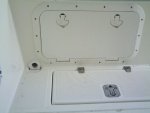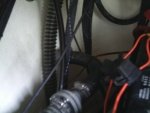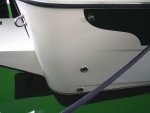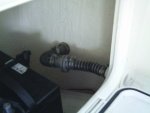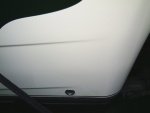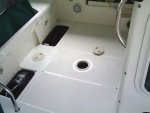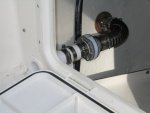Bill.Secure
New member
- Joined
- Aug 26, 2006
- Messages
- 118
- Reaction score
- 0
- C Dory Year
- 2007
- C Dory Model
- 25 Cruiser
- Hull Identification Number
- 25162
- Vessel Name
- Barnacle Bill
About two hours after a heavy rainstorm, I went down to the boat to affirm things were OK. I was rather surprised that there was still almost two inches of water in the cockpit up against the transom. This spoke well for the reduction in leakage into the bilge but very poorly about scupper drainage.
I decided to experiment a bit so today I removed the check valves with the intent of replacing them with 1 1/8" barbed connectors. Not being able to find connectors, I decided to re-gasket the check valves with rubber gasket stock leaving out the actual flapper which is part of the original gasket material. After I opened the first valve I noticed a notch on the outside circumference of the gasket above the flapper hinge.
Then it hit me... are the the check valves (for a roughly horizontal installation) supposed to be installed with the flapper hinge up? It makes sense, because if the hinge is down water flow through the valve will be impeded. If the hinge is up, the flap is down and water can flow past the flap more readily. Given that the notch was probably a cue to installers to install the valve notch up for "almost horizontal" installations , it only remained to pop down to the local boating store to see one of these valves in its original packaging and have the directions confirm the hypothesis.
The valves were there, directions did not exist, and the notch in the gasket material has been eliminated.
For the moment I'm going to see what happens without having a check valve in the scupper drain. My scuppers drain out the sides, not the transom as some of the earlier CD-25s did, so my options are limited. I can easily reinstall the old gaskets with the built in flapper if it make sense to do so.
The theory that the rotational orientation of the check valves makes a difference is also supported by comments I've seen on another thread about the drain rates for port and starboard scuppers being different. Draining will be fastest with the hinge up and flap down; slowest with the hinge down and flap up. The factory installers may have been unaware of the impact of rotational orientation.
A final note, since the folks at the boating store had been helpful on some related recent issues, I passed this information on to them while I was there. Three fairly knowledgeable staff members and a customer were all surprised because they always assumed these check valves would be installed vertically, where rotational orientation would make no difference.
Bill
Edgewater, MD
I decided to experiment a bit so today I removed the check valves with the intent of replacing them with 1 1/8" barbed connectors. Not being able to find connectors, I decided to re-gasket the check valves with rubber gasket stock leaving out the actual flapper which is part of the original gasket material. After I opened the first valve I noticed a notch on the outside circumference of the gasket above the flapper hinge.
Then it hit me... are the the check valves (for a roughly horizontal installation) supposed to be installed with the flapper hinge up? It makes sense, because if the hinge is down water flow through the valve will be impeded. If the hinge is up, the flap is down and water can flow past the flap more readily. Given that the notch was probably a cue to installers to install the valve notch up for "almost horizontal" installations , it only remained to pop down to the local boating store to see one of these valves in its original packaging and have the directions confirm the hypothesis.
The valves were there, directions did not exist, and the notch in the gasket material has been eliminated.
For the moment I'm going to see what happens without having a check valve in the scupper drain. My scuppers drain out the sides, not the transom as some of the earlier CD-25s did, so my options are limited. I can easily reinstall the old gaskets with the built in flapper if it make sense to do so.
The theory that the rotational orientation of the check valves makes a difference is also supported by comments I've seen on another thread about the drain rates for port and starboard scuppers being different. Draining will be fastest with the hinge up and flap down; slowest with the hinge down and flap up. The factory installers may have been unaware of the impact of rotational orientation.
A final note, since the folks at the boating store had been helpful on some related recent issues, I passed this information on to them while I was there. Three fairly knowledgeable staff members and a customer were all surprised because they always assumed these check valves would be installed vertically, where rotational orientation would make no difference.
Bill
Edgewater, MD

